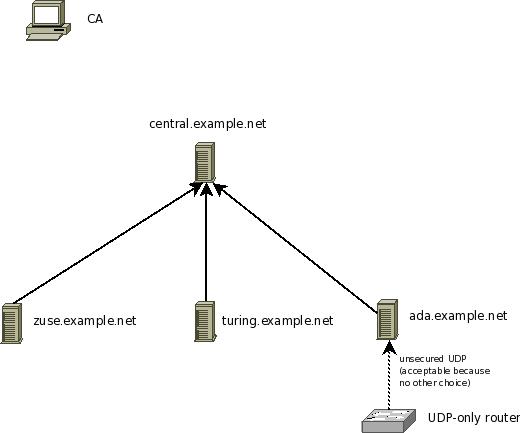Setting up a client¶
In this step, we configure a client machine. We from our scenario, we use zuse.example.net. You need to do the same steps for all other clients, too (in the example, that meanst turng.example.net). The client check’s the server’s identity and talks to it only if it is the expected server. This is a very important step. Without it, you would not detect man-in-the-middle attacks or simple malicious servers who try to get hold of your valuable log data.

Steps to do:
- make sure you have a functional CA (Setting up the CA)
- generate a machine certificate for zuse.example.net (follow instructions in Generating Machine Certificates)
- make sure you copy over ca.pem, machine-key.pem ad machine-cert.pem to the client. Ensure that no user except root can access them (even read permissions are really bad).
- configure the client so that it checks the server identity and sends messages only if the server identity is known. Please note that you have the same options as when configuring a server. However, we now use a single name only, because there is only one central server. No using wildcards make sure that we will exclusively talk to that server (otherwise, a compromised client may take over its role). If you load-balance to different server identities, you obviously need to allow all of them. It still is suggested to use explicit names.
At this point, please be reminded once again that your security needs may be quite different from what we assume in this tutorial. Evaluate your options based on your security needs.
Sample syslog.conf¶
Keep in mind that this rsyslog.conf sends messages via TCP, only. Also, we do not show any rules to write local files. Feel free to add them.
# make gtls driver the default
$DefaultNetstreamDriver gtls
# certificate files
$DefaultNetstreamDriverCAFile /rsyslog/protected/ca.pem
$DefaultNetstreamDriverCertFile /rsyslog/protected/machine-cert.pem
$DefaultNetstreamDriverKeyFile /rsyslog/protected/machine-key.pem
$ActionSendStreamDriverAuthMode x509/name
$ActionSendStreamDriverPermittedPeer central.example.net
$ActionSendStreamDriverMode 1 # run driver in TLS-only mode
*.* @@central.example.net:10514 # forward everything to remote server
Note: the example above forwards every message to the remote server. Of course, you can use the normal filters to restrict the set of information that is sent. Depending on your message volume and needs, this may be a smart thing to do.
Be sure to safeguard at least the private key (machine-key.pem)! If some third party obtains it, you security is broken!
See also
Help with configuring/using Rsyslog:
- Mailing list - best route for general questions
- GitHub: rsyslog source project - detailed questions, reporting issues
that are believed to be bugs with
Rsyslog - Stack Exchange (View, Ask) - experimental support from rsyslog community
See also
Contributing to Rsyslog:
- Source project: rsyslog project README.
- Documentation: rsyslog-doc project README